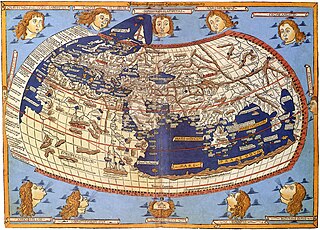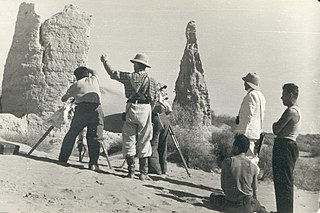Related Research Articles

Cartography is the study and practice of making and using maps. Combining science, aesthetics and technique, cartography builds on the premise that reality can be modeled in ways that communicate spatial information effectively.

A digital elevation model (DEM) or digital surface model (DSM) is a 3D computer graphics representation of elevation data to represent terrain or overlaying objects, commonly of a planet, moon, or asteroid. A "global DEM" refers to a discrete global grid. DEMs are used often in geographic information systems (GIS), and are the most common basis for digitally produced relief maps. A digital terrain model (DTM) represents specifically the ground surface while DEM and DSM may represent tree top canopy or building roofs.

Geomatics is defined in the ISO/TC 211 series of standards as the "discipline concerned with the collection, distribution, storage, analysis, processing, presentation of geographic data or geographic information". Under another definition, it consists of products, services and tools involved in the collection, integration and management of geographic (geospatial) data. It is also known as geomatic(s) engineering. Surveying engineering was the widely used name for geomatic(s) engineering in the past.
The American Congress on Surveying and Mapping (ACSM) was an American professional association representing the interests of those engaged in measuring and communicating geospatial data.
Geographic information science or geoinformation science is a scientific discipline at the crossroads of computational science, social science, and natural science that studies geographic information, including how it represents phenomena in the real world, how it represents the way humans understand the world, and how it can be captured, organized, and analyzed. It is a sub-field of geography, specifically part of technical geography. It has applications to both physical geography and human geography, although its techniques can be applied to many other fields of study as well as many different industries.
Beliefnet is a Christian lifestyle website featuring editorial content related to the topics of inspiration, spirituality, health, wellness, love and family, news, and entertainment.

MEdium Resolution Imaging Spectrometer (MERIS) was one of the main instruments on board the European Space Agency (ESA)'s Envisat platform. The sensor was in orbit from 2002 to 2012. ESA formally announced the end of Envisat's mission on 9 May 2012.

Michael I. Posner is an American psychologist who is a researcher in the field of attention, and the editor of numerous cognitive and neuroscience compilations. He is emeritus professor of psychology at the University of Oregon, and an adjunct professor at the Weill Medical College in New York. A Review of General Psychology survey, published in 2002, ranked Posner as the 56th most cited psychologist of the 20th century.

The Australian Height Datum was introduced in 1971 as the official vertical datum for Australia, and thereby serves as the benchmark to which all height measurements are referred. The Australian Height Datum is an amalgamation of decades of spirit levelling work conducted by numerous state and territory authorities across the country, and was corrected to align with the mean sea level observations of thirty tide gauges positioned around the entire coastline. While it remains the published vertical datum for all surveying and engineering operations performed throughout Australia, newer technologies have uncovered numerous deficiencies, offsets and distortions within the Australian Height Datum, leading to discussions about defining a new Australian vertical datum.

Web mapping or an online mapping is the process of using maps, usually created through geographic information systems (GIS) on the World Wide Web. A web map or an online map is both served and consumed, thus, web mapping is more than just web cartography, it is a service where consumers may choose what the map will show.

Geography is a field of science devoted to the study of the lands, features, inhabitants, and phenomena of Earth. Geography is an all-encompassing discipline that seeks an understanding of Earth and its human and natural complexities—not merely where objects are, but also how they have changed and come to be. While geography is specific to Earth, many concepts can be applied more broadly to other celestial bodies in the field of planetary science. Geography has been called "a bridge between natural science and social science disciplines."
Physicalization of computer hardware, is a way to place multiple physical machines in a rack unit. It can be a way to reduce hardware costs, since in some cases, server processors cost more per core than energy efficient laptop processors, which may make up for added cost of board level integration. While Moore's law makes increasing integration less expensive, some jobs require much I/O bandwidth, which may be less expensive to provide using many less-integrated processors.
Tactician Corporation is a developer and provider of GIS desktop software, SaaS web software, and business intelligence consulting services internationally. The company has its headquarters in Massachusetts, United States.
The Journal of Spatial Science is an academic journal about spatial sciences published by Taylor & Francis on behalf of the Mapping Sciences Institute (Australia) and the Surveying and Spatial Sciences Institute. It covers cartography, geodesy, geographic information science, hydrography, digital image analysis and photogrammetry, remote sensing, surveying and related areas. Its editor-in-chief is Graeme Wright; its 2018 impact factor is 1.711.

Keith Charles Clarke is a professor of Analytical Cartography and Modelling in the Department of Geography at the University of California, Santa Barbara, USA.
Reinhard Moratz is a German science educator, academic and researcher. He is Ausserplanmässiger Professor at the University of Münster’s Institute for Geoinformatics. He has worked on spatial cognition and reasoning, qualitative theories of low-dimensional entities like straight line segments and oriented points, artificial intelligence and specifically the OPRA calculus. His research is based on computational models that account for the varying reference frames used in giving verbal instructions about navigation.

Alexander James Kent is a British cartographer, geographer and academic, currently serving as Vice President of the International Cartographic Association. He leads the Coastal Connections Project for World Monuments Fund and English Heritage and is honorary Reader in Cartography and Geographical Information Science at Canterbury Christ Church University (CCCU) and also a senior research associate of the Oxford Centre for Islamic Studies at the University of Oxford.
Graciela Metternicht is a Belgian researcher on environmental geography.
Haifaa Jawad is an Iraqi Muslim scholar and Honorary Senior Lecturer of theology and religion at the University of Birmingham.
Technical geography is the branch of geography that involves using, studying, and creating tools to obtain, analyze, interpret, understand, and communicate spatial information. The other branches, most commonly limited to human geography and physical geography, can usually apply the concepts and techniques of technical geography. However, the methods and theory are distinct, and a technical geographer may be more concerned with the technological and theoretical concepts than the nature of the data. Further, a technical geographer may explore the relationship between the spatial technology and the end users to improve upon the technology and better understand the impact of the technology on human behavior. Thus, the spatial data types a technical geographer employs may vary widely, including human and physical geography topics, with the common thread being the techniques and philosophies employed. To accomplish this, technical geographers often create their own software or scripts, which can then be applied more broadly by others. They may also explore applying techniques developed for one application to another unrelated topic, such as applying Kriging, originally developed for mining, to disciplines as diverse as real-estate prices. such as the While technical geography mostly works with quantitative data, the techniques and technology can be applied to qualitative geography, differentiating it from quantitative geography. Within the branch of technical geography are the major and overlapping subbranches of geographic information science, geomatics, and geoinformatics.
References
- ↑ "About". Mapping Sciences Institute, Australia. Retrieved 2021-01-04.
- ↑ Smith, Keith (2002). "Mapping Sciences Institute, Australia". Cartography. Informa UK Limited. 31 (1): 136. doi:10.1080/00690805.2002.9714193. ISSN 0069-0805. S2CID 128567396.
- ↑ Cartwright, William (1999). "Mapping Sciences Institute, Australia". Cartography. Informa UK Limited. 28 (1): 43–68. doi:10.1080/00690805.1999.9714300. ISSN 0069-0805.
- ↑ "Heritage". Mapping Sciences Institute, Australia. Retrieved 2021-01-03.